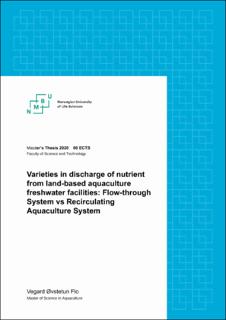| dc.description.abstract | Salmon farming is a large and still growing industry in Norway. Like all industries that utilize a country’s natural resources, will lack of focus on the environmental impact potentially lead to negative consequences. To ensure sustainability and protect the environment, the Norwegian government use production licenses and emission permits to determine how large a salmon production can be, without adversely affecting the recipient water. There is restricted knowledge about the emission from land-based juvenile farms and about the difference between flow-through and a RAS in terms of emissions. In addition, are the licenses given by the county governor office, potentially leading to different practices between the different counties.
This master thesis asses this subject further by looking into two research questions:
• Does the licensing system urge or stimulate to reduce the emissions from land-based salmon farms, both FTS and RAS?
• Is it possible to develop a better model for calculation of emissions from land-based salmon farms, both FTS and RAS?
To answer these two questions the master is worked out in three parts:
1. Assessment of today's emission permits for land-based freshwater facilities, FTS and RAS
2. Development of a new model (VØF) for calculation of waste from land-based freshwater facilities, based on production system, production plan and mass balance estimates
3. Comparing VØF-model to the models used by the county governor’s office for estimation of waste from land-based aquaculture freshwater facilities.
Today most of the emission permits demand a percentage purification of the total production without separating dissolved and particle waste and is more often given to RAS-facilities. This may lead to an incorrect assumption of the emissions from a facility because the tonnage waste produced and released is never actually specified. Secondly, will restrictions in terms of maximum feed usage, biomass, and the number of fish produced, give no room or motivation for self-improvement to reduce waste more effectively. If not tended to, this waste licensing system will certainly not improve the industries sustainability in the upcoming future.
Since the waste from fish farms is dependent on the feed, the feed content for different salmon life stages was mapped. In addition, literature shows that the salmon in average excrete following values of the total nutrient input: 18,33% of C, 52% of P and 15,40% of N as particulate waste, and 3% of C, 18% of P, and 44,40% of N as dissolved waste. The remaining C waste is discharged over the gills of the salmon in the form of 41% CO2.
The new model (VØF-model) estimated waste with the mass balance principle with a literature background of distribution from a 100% feed input. In this thesis, the feed input to the model was based on six theoretical production plans with weekly calculations on biological needs in salmon production. The production plans simulated production of 100 000 salmon smolt for the sizes 100g, 300g, and 500g, in both FTS and RAS. The focus in the VØF-model is chosen to locate differences in nutrient content of C, P, and N in salmon waste from FTS and RAS.
The VØF-model showed that the total average feed content changed with the different compositions in fry, fingerling, and smolt feed. The model also showed the following overall average content in RAS feed, compared to FTS feed for production of the three fish sizes:
- 6,5 g/kg less C, 5,0 g/kg less N and 0,2 g/kg more P in a 100 g production,
- 7,2 g/kg less C, 3,4 g/kg less N and 1,3 g/kg more P in a 300g production,
- 6,8 g/kg less C, 3,2 g/kg less N and 1,4 g/kg more P in a 500g production,
This thesis demonstrated that both particle waste production and dissolved waste production from salmon, strongly correlates with the feed input, as a total and on a weekly basis, as well as the production plan. From this, it is clear that the water temperature, which is heavily affecting growth, is a crucial factor for waste production and is responsible for causing substantial waste differences between the FTS and RAS productions, but also between the 100g, 300g and 500g productions in general. Results showed that salmon waste produced under RAS conditions had following differences compared to salmon waste produced under FTS conditions:
- 0,85% less C, 6,29% less N and 1,42% more P in the 100g,
- 1% less C, 4,06% less N and 8,27% more P in the 300g,
- 1,53% less C, 4,44% less N and 8,72% more P in the 500g,
Results indicate that in land-based salmon farming, particle waste makes up 85,94% of C, 74,29% of P and 25,75% of N of the total waste produced. Theoretically, this part of the waste is simpler and more cost-effective for farmers to purify, compared to the remaining dissolved part.
When comparing the VØF-model to the government's newest estimation model, the highest percentage deviation in total waste from the VØF-model was, C + 11,13% (500g RAS), P +18,51% (500g FTS) and N – 6,13%. As the government’s model calculated the amount of DW in sludge to increase with increasing fish size, this DW variation presumably lead to an inaccurate estimation according to the mass balance principle for salmon used in the VØF-model.
The new county governor model did not acknowledge the difference of C, P, and N content in the feed, the variations of these nutrients through the production cycle, and how this affected the overall production of waste. The sum of these factors results in a miscalculation of the dissolved waste produced when estimating with the new county governor model, compared to the VØF-model, with the highest percentage deviation being C +79,12% (500g RAS), P +71,97% (500g FTS) and N -8,26% (500g RAS). | en_US |

